Advantages and Disadvantages of Social Networks in Business: A Review
VerifiedAdded on 2020/03/13
|12
|3254
|56
Literature Review
AI Summary
This literature review explores the multifaceted role of social networks in contemporary business practices. It begins by defining social networks and their evolution, emphasizing their significance in modern communication and marketing. The review then delves into the practical applications of social networks in business, highlighting their use in promotion, marketing, and direct consumer engagement. It meticulously outlines the advantages, such as increased brand awareness, consumer loyalty, targeted marketing capabilities, and cost-effective promotional strategies. Conversely, the review critically examines the disadvantages, including the potential for misaligned marketing strategies, resource-intensive management, negative feedback, security risks, and challenges in quantifying return on investment. The analysis also considers the impact of social networks on business, emphasizing the importance of consistent engagement, creative marketing tactics, and the need to adapt to the evolving digital landscape. The review draws upon a range of academic sources to provide a comprehensive overview of the subject, offering valuable insights into the strategic use of social networks in achieving business objectives.

Running head: LITERATURE REVIEW
LITERATURE REVIEW
Advantages and disadvantages of using social network in business
Name of the Student:
Name of the University:
Author Note:
LITERATURE REVIEW
Advantages and disadvantages of using social network in business
Name of the Student:
Name of the University:
Author Note:
Paraphrase This Document
Need a fresh take? Get an instant paraphrase of this document with our AI Paraphraser
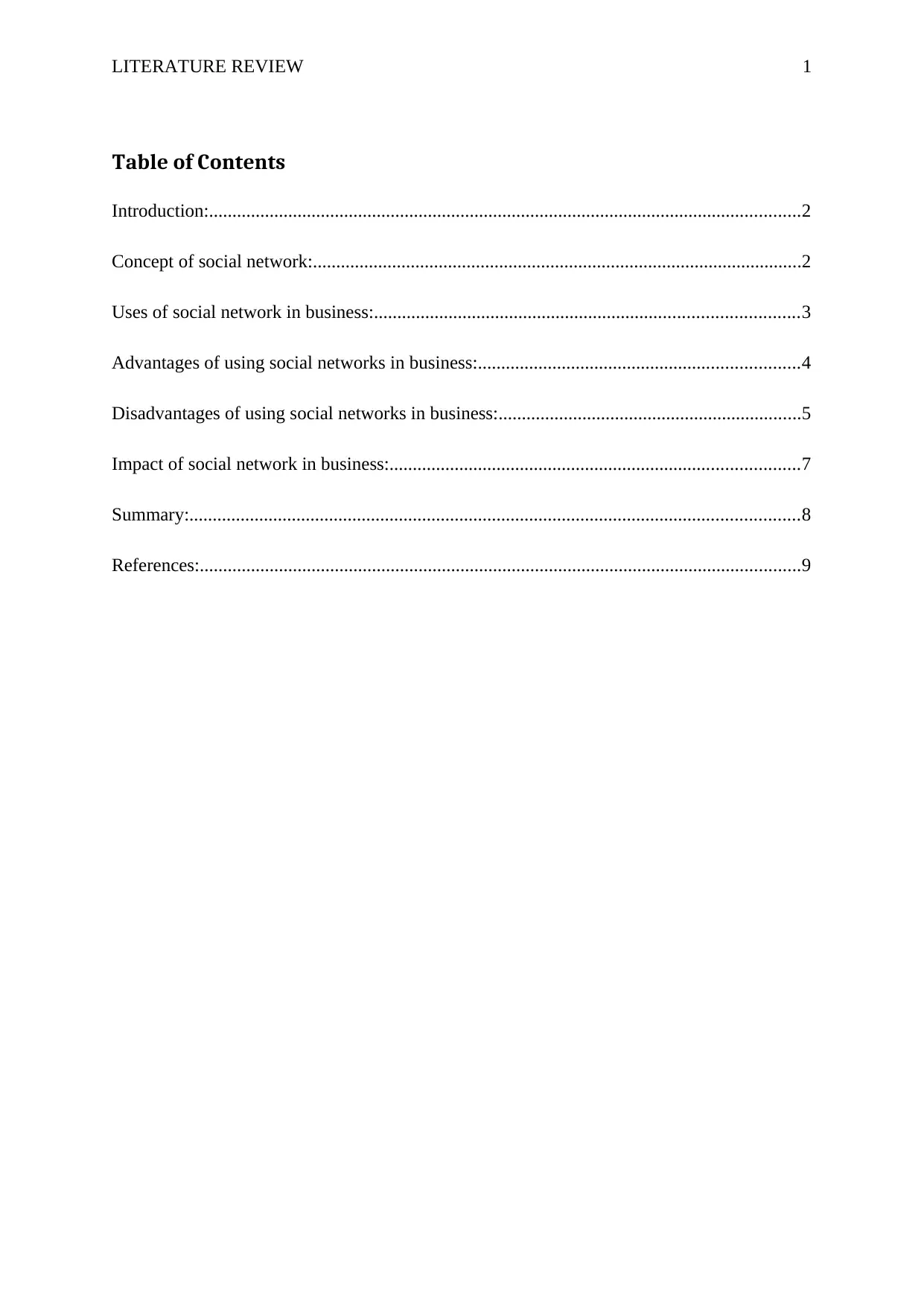
LITERATURE REVIEW 1
Table of Contents
Introduction:...............................................................................................................................2
Concept of social network:.........................................................................................................2
Uses of social network in business:...........................................................................................3
Advantages of using social networks in business:.....................................................................4
Disadvantages of using social networks in business:.................................................................5
Impact of social network in business:........................................................................................7
Summary:...................................................................................................................................8
References:.................................................................................................................................9
Table of Contents
Introduction:...............................................................................................................................2
Concept of social network:.........................................................................................................2
Uses of social network in business:...........................................................................................3
Advantages of using social networks in business:.....................................................................4
Disadvantages of using social networks in business:.................................................................5
Impact of social network in business:........................................................................................7
Summary:...................................................................................................................................8
References:.................................................................................................................................9

LITERATURE REVIEW 2
Introduction:
Social media has provided the ability to contact and people irrespective of meeting
them. In the view point of Scott (2017), the social networks like Twitter and Facebook have
become the most used media platform to communicate. The easier means to communicate
and reaching out to people has made it important to include the social network in the business
activities. In business, social networks are used for the sake of promotion and marketing as a
method of communicating with the consumers. As pointed out by Lin et al. 2014, for small
businesses where the budget of market and promotion is kept low, social networks act as a
savior to these companies. Moreover, in the recent time with the increased use of smart
phones and application-based live activities the social networks have turn out to be an
important part of life of every individual that has automatically made it easier for major
businesses to use the social networks to reach out the particular target group of people.
The concept of social network:
As stated by Jussila et al. (2014), social network is the social structure that is made up
of several social actors that aim at carrying out social interaction among the associated
people. In order to communicate in the world of the social media, it is important to analyze
the global and the social entities as well as the theories of social networking that would help
to explain the pattern how the social network works. Ellison and Boyd (2013) have explained
the concept of social networking. According to Ellison and Boyd (2013), social networking is
the practice of expanding the business by making social contacts or increasing
communication by the widely used social networking media sites like Facebook and Twitter.
According to the concept of six degrees of separation, any two people on this planet can
make contact with each other through communication chains or by establishing online
communities using the social media. Thus, there would be no longer to meet an individual
Introduction:
Social media has provided the ability to contact and people irrespective of meeting
them. In the view point of Scott (2017), the social networks like Twitter and Facebook have
become the most used media platform to communicate. The easier means to communicate
and reaching out to people has made it important to include the social network in the business
activities. In business, social networks are used for the sake of promotion and marketing as a
method of communicating with the consumers. As pointed out by Lin et al. 2014, for small
businesses where the budget of market and promotion is kept low, social networks act as a
savior to these companies. Moreover, in the recent time with the increased use of smart
phones and application-based live activities the social networks have turn out to be an
important part of life of every individual that has automatically made it easier for major
businesses to use the social networks to reach out the particular target group of people.
The concept of social network:
As stated by Jussila et al. (2014), social network is the social structure that is made up
of several social actors that aim at carrying out social interaction among the associated
people. In order to communicate in the world of the social media, it is important to analyze
the global and the social entities as well as the theories of social networking that would help
to explain the pattern how the social network works. Ellison and Boyd (2013) have explained
the concept of social networking. According to Ellison and Boyd (2013), social networking is
the practice of expanding the business by making social contacts or increasing
communication by the widely used social networking media sites like Facebook and Twitter.
According to the concept of six degrees of separation, any two people on this planet can
make contact with each other through communication chains or by establishing online
communities using the social media. Thus, there would be no longer to meet an individual
⊘ This is a preview!⊘
Do you want full access?
Subscribe today to unlock all pages.

Trusted by 1+ million students worldwide

LITERATURE REVIEW 3
and subsequently, connections can be made to other members. This would definitely improve
the quality of service and the means of communication and it would be rather easier to be in
contact with any member of the society irrespective of the distances between the two persons.
Social networks have evolved highly in the society and it is the unparalleled potential
and the web facility that has helped in the expansion of the major social network sites. In
addition to this, these social media platforms have increasingly contributed towards building
the business applications in order to communicate as well as to build up businesses
(Bharadwaj et al. 2013). There is no doubt that with the introduction of the computers, the
business structure and networking have changed drastically. With the involvement of the
social media sites, the use of the computer and its application in business has taken a new
turn and has made it easier to reach out the target group of people irrespective of the distance
between the business and the people.
Uses of social network in business:
As pointed out by Maier et al. (2015), the two most important perspectives of the
social media are to make better communication and reach out people irrespective of the
distance and gap between the target group and the actual business head. In the recent time,
there are more than 3 billion internet users with almost 2 billion active social networking
media users. This has given the opportunity to the small and big businesses to take active use
of the social networks and reach out the people with the message that they intend to send. The
most popular social networking site is the Facebook (Ngai et al. 2015). The business model
of this social network is not to sell any product but to offer space to the businesses bodies that
would be used for the sake of marketing and promotion. The idea of this kind of promotion is
to reach out the consumers directly because the advertisements will appear on the mobile or
the computer screens. Thus, this mode of promotion gives an opportunity to the marketers to
directly communicate with the consumers. Moreover, the cost and expenditure that is spent
and subsequently, connections can be made to other members. This would definitely improve
the quality of service and the means of communication and it would be rather easier to be in
contact with any member of the society irrespective of the distances between the two persons.
Social networks have evolved highly in the society and it is the unparalleled potential
and the web facility that has helped in the expansion of the major social network sites. In
addition to this, these social media platforms have increasingly contributed towards building
the business applications in order to communicate as well as to build up businesses
(Bharadwaj et al. 2013). There is no doubt that with the introduction of the computers, the
business structure and networking have changed drastically. With the involvement of the
social media sites, the use of the computer and its application in business has taken a new
turn and has made it easier to reach out the target group of people irrespective of the distance
between the business and the people.
Uses of social network in business:
As pointed out by Maier et al. (2015), the two most important perspectives of the
social media are to make better communication and reach out people irrespective of the
distance and gap between the target group and the actual business head. In the recent time,
there are more than 3 billion internet users with almost 2 billion active social networking
media users. This has given the opportunity to the small and big businesses to take active use
of the social networks and reach out the people with the message that they intend to send. The
most popular social networking site is the Facebook (Ngai et al. 2015). The business model
of this social network is not to sell any product but to offer space to the businesses bodies that
would be used for the sake of marketing and promotion. The idea of this kind of promotion is
to reach out the consumers directly because the advertisements will appear on the mobile or
the computer screens. Thus, this mode of promotion gives an opportunity to the marketers to
directly communicate with the consumers. Moreover, the cost and expenditure that is spent
Paraphrase This Document
Need a fresh take? Get an instant paraphrase of this document with our AI Paraphraser
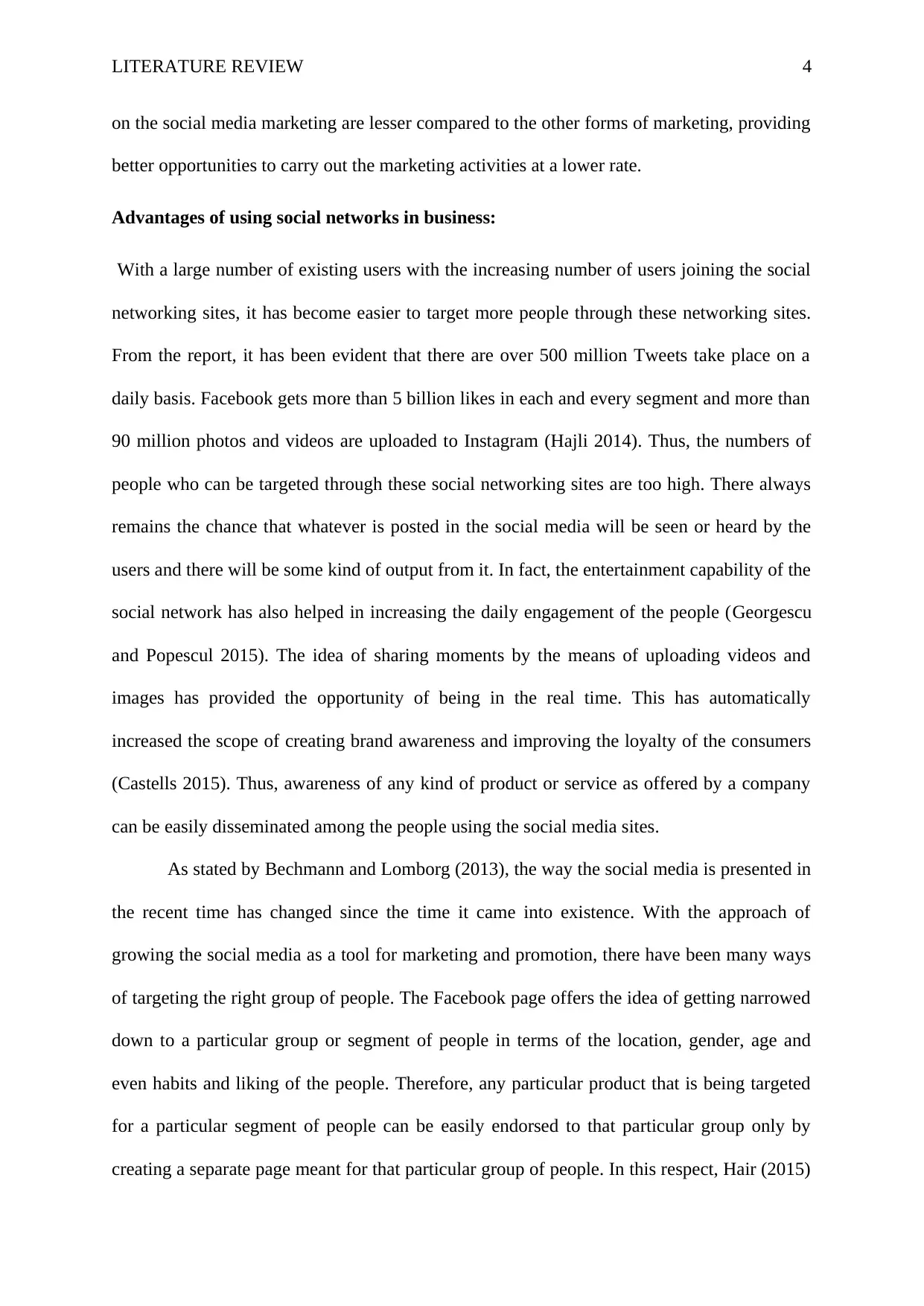
LITERATURE REVIEW 4
on the social media marketing are lesser compared to the other forms of marketing, providing
better opportunities to carry out the marketing activities at a lower rate.
Advantages of using social networks in business:
With a large number of existing users with the increasing number of users joining the social
networking sites, it has become easier to target more people through these networking sites.
From the report, it has been evident that there are over 500 million Tweets take place on a
daily basis. Facebook gets more than 5 billion likes in each and every segment and more than
90 million photos and videos are uploaded to Instagram (Hajli 2014). Thus, the numbers of
people who can be targeted through these social networking sites are too high. There always
remains the chance that whatever is posted in the social media will be seen or heard by the
users and there will be some kind of output from it. In fact, the entertainment capability of the
social network has also helped in increasing the daily engagement of the people (Georgescu
and Popescul 2015). The idea of sharing moments by the means of uploading videos and
images has provided the opportunity of being in the real time. This has automatically
increased the scope of creating brand awareness and improving the loyalty of the consumers
(Castells 2015). Thus, awareness of any kind of product or service as offered by a company
can be easily disseminated among the people using the social media sites.
As stated by Bechmann and Lomborg (2013), the way the social media is presented in
the recent time has changed since the time it came into existence. With the approach of
growing the social media as a tool for marketing and promotion, there have been many ways
of targeting the right group of people. The Facebook page offers the idea of getting narrowed
down to a particular group or segment of people in terms of the location, gender, age and
even habits and liking of the people. Therefore, any particular product that is being targeted
for a particular segment of people can be easily endorsed to that particular group only by
creating a separate page meant for that particular group of people. In this respect, Hair (2015)
on the social media marketing are lesser compared to the other forms of marketing, providing
better opportunities to carry out the marketing activities at a lower rate.
Advantages of using social networks in business:
With a large number of existing users with the increasing number of users joining the social
networking sites, it has become easier to target more people through these networking sites.
From the report, it has been evident that there are over 500 million Tweets take place on a
daily basis. Facebook gets more than 5 billion likes in each and every segment and more than
90 million photos and videos are uploaded to Instagram (Hajli 2014). Thus, the numbers of
people who can be targeted through these social networking sites are too high. There always
remains the chance that whatever is posted in the social media will be seen or heard by the
users and there will be some kind of output from it. In fact, the entertainment capability of the
social network has also helped in increasing the daily engagement of the people (Georgescu
and Popescul 2015). The idea of sharing moments by the means of uploading videos and
images has provided the opportunity of being in the real time. This has automatically
increased the scope of creating brand awareness and improving the loyalty of the consumers
(Castells 2015). Thus, awareness of any kind of product or service as offered by a company
can be easily disseminated among the people using the social media sites.
As stated by Bechmann and Lomborg (2013), the way the social media is presented in
the recent time has changed since the time it came into existence. With the approach of
growing the social media as a tool for marketing and promotion, there have been many ways
of targeting the right group of people. The Facebook page offers the idea of getting narrowed
down to a particular group or segment of people in terms of the location, gender, age and
even habits and liking of the people. Therefore, any particular product that is being targeted
for a particular segment of people can be easily endorsed to that particular group only by
creating a separate page meant for that particular group of people. In this respect, Hair (2015)
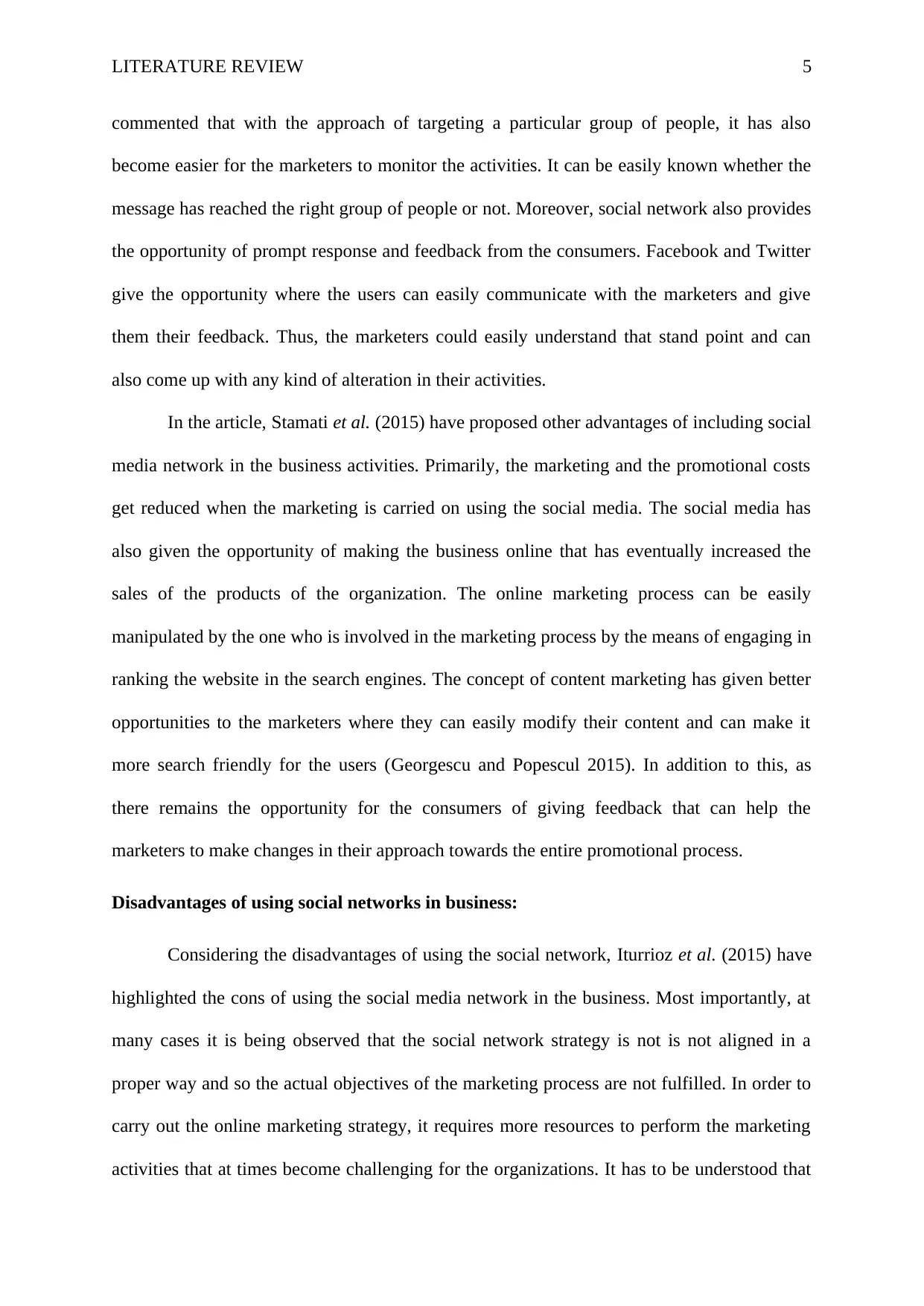
LITERATURE REVIEW 5
commented that with the approach of targeting a particular group of people, it has also
become easier for the marketers to monitor the activities. It can be easily known whether the
message has reached the right group of people or not. Moreover, social network also provides
the opportunity of prompt response and feedback from the consumers. Facebook and Twitter
give the opportunity where the users can easily communicate with the marketers and give
them their feedback. Thus, the marketers could easily understand that stand point and can
also come up with any kind of alteration in their activities.
In the article, Stamati et al. (2015) have proposed other advantages of including social
media network in the business activities. Primarily, the marketing and the promotional costs
get reduced when the marketing is carried on using the social media. The social media has
also given the opportunity of making the business online that has eventually increased the
sales of the products of the organization. The online marketing process can be easily
manipulated by the one who is involved in the marketing process by the means of engaging in
ranking the website in the search engines. The concept of content marketing has given better
opportunities to the marketers where they can easily modify their content and can make it
more search friendly for the users (Georgescu and Popescul 2015). In addition to this, as
there remains the opportunity for the consumers of giving feedback that can help the
marketers to make changes in their approach towards the entire promotional process.
Disadvantages of using social networks in business:
Considering the disadvantages of using the social network, Iturrioz et al. (2015) have
highlighted the cons of using the social media network in the business. Most importantly, at
many cases it is being observed that the social network strategy is not is not aligned in a
proper way and so the actual objectives of the marketing process are not fulfilled. In order to
carry out the online marketing strategy, it requires more resources to perform the marketing
activities that at times become challenging for the organizations. It has to be understood that
commented that with the approach of targeting a particular group of people, it has also
become easier for the marketers to monitor the activities. It can be easily known whether the
message has reached the right group of people or not. Moreover, social network also provides
the opportunity of prompt response and feedback from the consumers. Facebook and Twitter
give the opportunity where the users can easily communicate with the marketers and give
them their feedback. Thus, the marketers could easily understand that stand point and can
also come up with any kind of alteration in their activities.
In the article, Stamati et al. (2015) have proposed other advantages of including social
media network in the business activities. Primarily, the marketing and the promotional costs
get reduced when the marketing is carried on using the social media. The social media has
also given the opportunity of making the business online that has eventually increased the
sales of the products of the organization. The online marketing process can be easily
manipulated by the one who is involved in the marketing process by the means of engaging in
ranking the website in the search engines. The concept of content marketing has given better
opportunities to the marketers where they can easily modify their content and can make it
more search friendly for the users (Georgescu and Popescul 2015). In addition to this, as
there remains the opportunity for the consumers of giving feedback that can help the
marketers to make changes in their approach towards the entire promotional process.
Disadvantages of using social networks in business:
Considering the disadvantages of using the social network, Iturrioz et al. (2015) have
highlighted the cons of using the social media network in the business. Most importantly, at
many cases it is being observed that the social network strategy is not is not aligned in a
proper way and so the actual objectives of the marketing process are not fulfilled. In order to
carry out the online marketing strategy, it requires more resources to perform the marketing
activities that at times become challenging for the organizations. It has to be understood that
⊘ This is a preview!⊘
Do you want full access?
Subscribe today to unlock all pages.

Trusted by 1+ million students worldwide
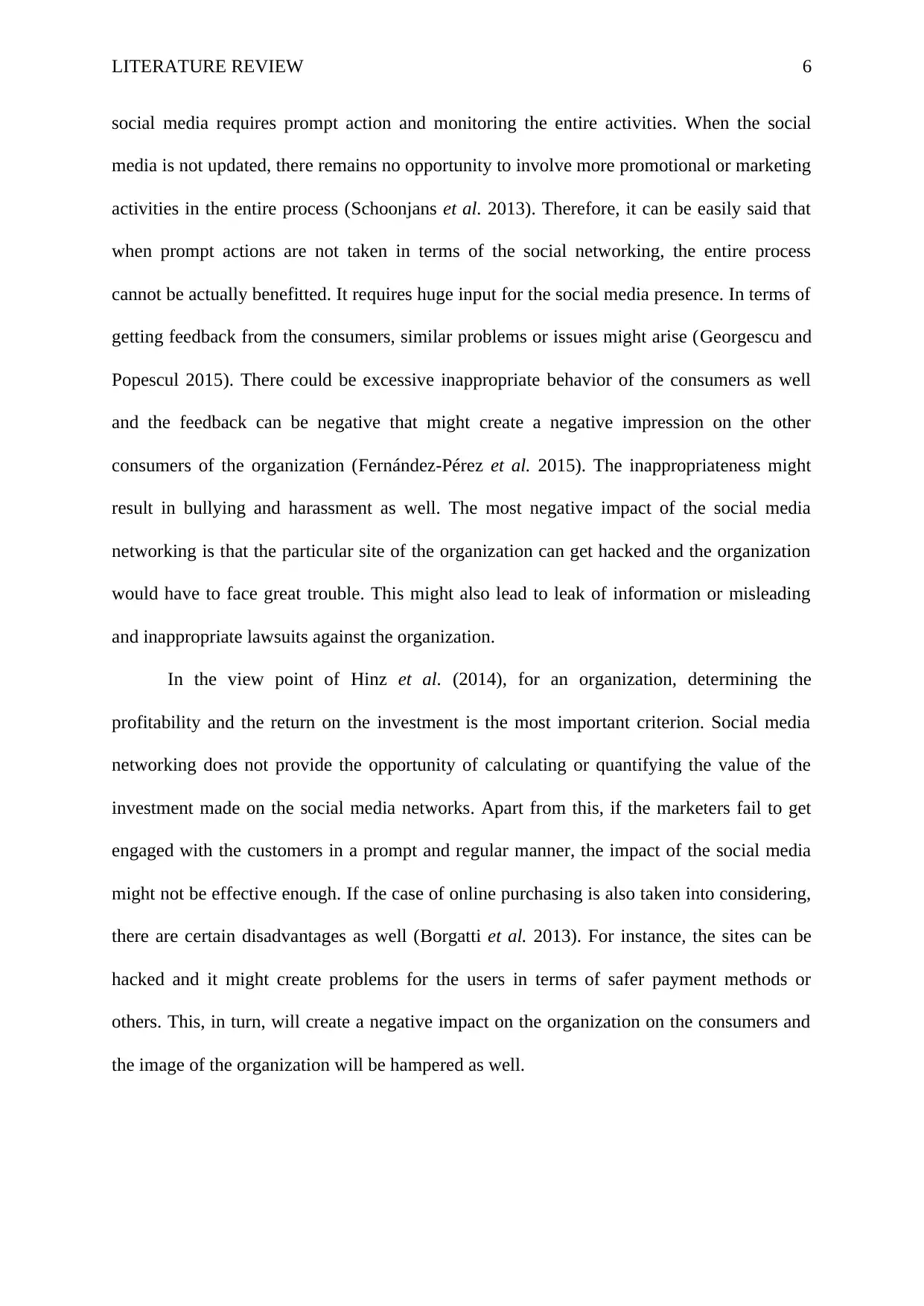
LITERATURE REVIEW 6
social media requires prompt action and monitoring the entire activities. When the social
media is not updated, there remains no opportunity to involve more promotional or marketing
activities in the entire process (Schoonjans et al. 2013). Therefore, it can be easily said that
when prompt actions are not taken in terms of the social networking, the entire process
cannot be actually benefitted. It requires huge input for the social media presence. In terms of
getting feedback from the consumers, similar problems or issues might arise (Georgescu and
Popescul 2015). There could be excessive inappropriate behavior of the consumers as well
and the feedback can be negative that might create a negative impression on the other
consumers of the organization (Fernández-Pérez et al. 2015). The inappropriateness might
result in bullying and harassment as well. The most negative impact of the social media
networking is that the particular site of the organization can get hacked and the organization
would have to face great trouble. This might also lead to leak of information or misleading
and inappropriate lawsuits against the organization.
In the view point of Hinz et al. (2014), for an organization, determining the
profitability and the return on the investment is the most important criterion. Social media
networking does not provide the opportunity of calculating or quantifying the value of the
investment made on the social media networks. Apart from this, if the marketers fail to get
engaged with the customers in a prompt and regular manner, the impact of the social media
might not be effective enough. If the case of online purchasing is also taken into considering,
there are certain disadvantages as well (Borgatti et al. 2013). For instance, the sites can be
hacked and it might create problems for the users in terms of safer payment methods or
others. This, in turn, will create a negative impact on the organization on the consumers and
the image of the organization will be hampered as well.
social media requires prompt action and monitoring the entire activities. When the social
media is not updated, there remains no opportunity to involve more promotional or marketing
activities in the entire process (Schoonjans et al. 2013). Therefore, it can be easily said that
when prompt actions are not taken in terms of the social networking, the entire process
cannot be actually benefitted. It requires huge input for the social media presence. In terms of
getting feedback from the consumers, similar problems or issues might arise (Georgescu and
Popescul 2015). There could be excessive inappropriate behavior of the consumers as well
and the feedback can be negative that might create a negative impression on the other
consumers of the organization (Fernández-Pérez et al. 2015). The inappropriateness might
result in bullying and harassment as well. The most negative impact of the social media
networking is that the particular site of the organization can get hacked and the organization
would have to face great trouble. This might also lead to leak of information or misleading
and inappropriate lawsuits against the organization.
In the view point of Hinz et al. (2014), for an organization, determining the
profitability and the return on the investment is the most important criterion. Social media
networking does not provide the opportunity of calculating or quantifying the value of the
investment made on the social media networks. Apart from this, if the marketers fail to get
engaged with the customers in a prompt and regular manner, the impact of the social media
might not be effective enough. If the case of online purchasing is also taken into considering,
there are certain disadvantages as well (Borgatti et al. 2013). For instance, the sites can be
hacked and it might create problems for the users in terms of safer payment methods or
others. This, in turn, will create a negative impact on the organization on the consumers and
the image of the organization will be hampered as well.
Paraphrase This Document
Need a fresh take? Get an instant paraphrase of this document with our AI Paraphraser
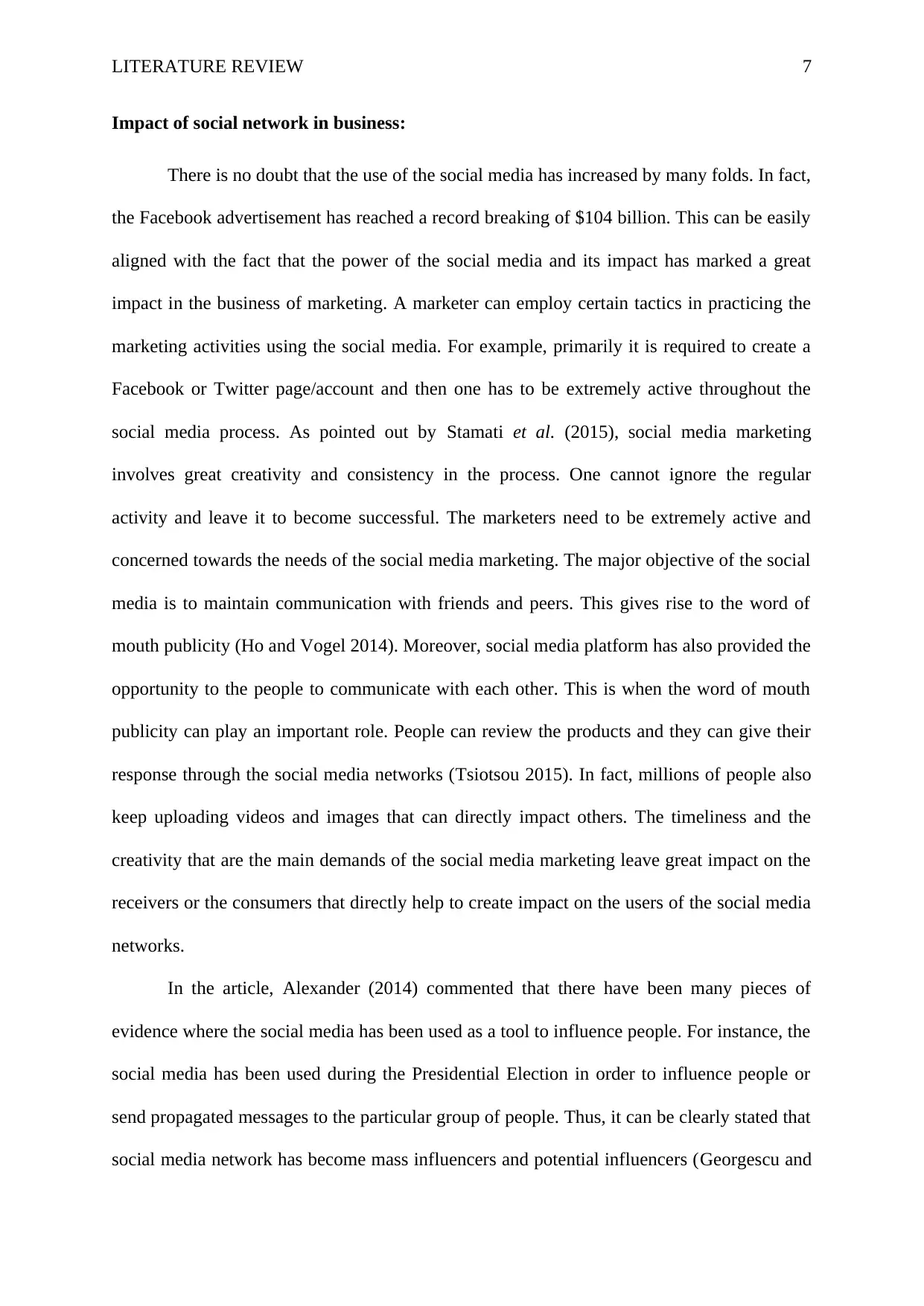
LITERATURE REVIEW 7
Impact of social network in business:
There is no doubt that the use of the social media has increased by many folds. In fact,
the Facebook advertisement has reached a record breaking of $104 billion. This can be easily
aligned with the fact that the power of the social media and its impact has marked a great
impact in the business of marketing. A marketer can employ certain tactics in practicing the
marketing activities using the social media. For example, primarily it is required to create a
Facebook or Twitter page/account and then one has to be extremely active throughout the
social media process. As pointed out by Stamati et al. (2015), social media marketing
involves great creativity and consistency in the process. One cannot ignore the regular
activity and leave it to become successful. The marketers need to be extremely active and
concerned towards the needs of the social media marketing. The major objective of the social
media is to maintain communication with friends and peers. This gives rise to the word of
mouth publicity (Ho and Vogel 2014). Moreover, social media platform has also provided the
opportunity to the people to communicate with each other. This is when the word of mouth
publicity can play an important role. People can review the products and they can give their
response through the social media networks (Tsiotsou 2015). In fact, millions of people also
keep uploading videos and images that can directly impact others. The timeliness and the
creativity that are the main demands of the social media marketing leave great impact on the
receivers or the consumers that directly help to create impact on the users of the social media
networks.
In the article, Alexander (2014) commented that there have been many pieces of
evidence where the social media has been used as a tool to influence people. For instance, the
social media has been used during the Presidential Election in order to influence people or
send propagated messages to the particular group of people. Thus, it can be clearly stated that
social media network has become mass influencers and potential influencers (Georgescu and
Impact of social network in business:
There is no doubt that the use of the social media has increased by many folds. In fact,
the Facebook advertisement has reached a record breaking of $104 billion. This can be easily
aligned with the fact that the power of the social media and its impact has marked a great
impact in the business of marketing. A marketer can employ certain tactics in practicing the
marketing activities using the social media. For example, primarily it is required to create a
Facebook or Twitter page/account and then one has to be extremely active throughout the
social media process. As pointed out by Stamati et al. (2015), social media marketing
involves great creativity and consistency in the process. One cannot ignore the regular
activity and leave it to become successful. The marketers need to be extremely active and
concerned towards the needs of the social media marketing. The major objective of the social
media is to maintain communication with friends and peers. This gives rise to the word of
mouth publicity (Ho and Vogel 2014). Moreover, social media platform has also provided the
opportunity to the people to communicate with each other. This is when the word of mouth
publicity can play an important role. People can review the products and they can give their
response through the social media networks (Tsiotsou 2015). In fact, millions of people also
keep uploading videos and images that can directly impact others. The timeliness and the
creativity that are the main demands of the social media marketing leave great impact on the
receivers or the consumers that directly help to create impact on the users of the social media
networks.
In the article, Alexander (2014) commented that there have been many pieces of
evidence where the social media has been used as a tool to influence people. For instance, the
social media has been used during the Presidential Election in order to influence people or
send propagated messages to the particular group of people. Thus, it can be clearly stated that
social media network has become mass influencers and potential influencers (Georgescu and

LITERATURE REVIEW 8
Popescul 2015). It is a unique way to engage the target group of people and at the same time,
keeping people updated with the regular happenings carried on in an organization. It is the
easier and the fastest method of reaching out people and informs them about the
organizational activities.
Summary:
The literature review has highlighted the importance of social networking in carrying
out the marketing and the promotional activities of an organization. Keeping the advantages
of using the social network, every big and small organization is implementing the social
network as a tool for their marketing. This has definitely created a direct impact on the
overall business activities of the organization. In fact, the impact of social media has reached
to that level that no particular organization can think of carrying out its business activities
without the social media network.
Popescul 2015). It is a unique way to engage the target group of people and at the same time,
keeping people updated with the regular happenings carried on in an organization. It is the
easier and the fastest method of reaching out people and informs them about the
organizational activities.
Summary:
The literature review has highlighted the importance of social networking in carrying
out the marketing and the promotional activities of an organization. Keeping the advantages
of using the social network, every big and small organization is implementing the social
network as a tool for their marketing. This has definitely created a direct impact on the
overall business activities of the organization. In fact, the impact of social media has reached
to that level that no particular organization can think of carrying out its business activities
without the social media network.
⊘ This is a preview!⊘
Do you want full access?
Subscribe today to unlock all pages.

Trusted by 1+ million students worldwide
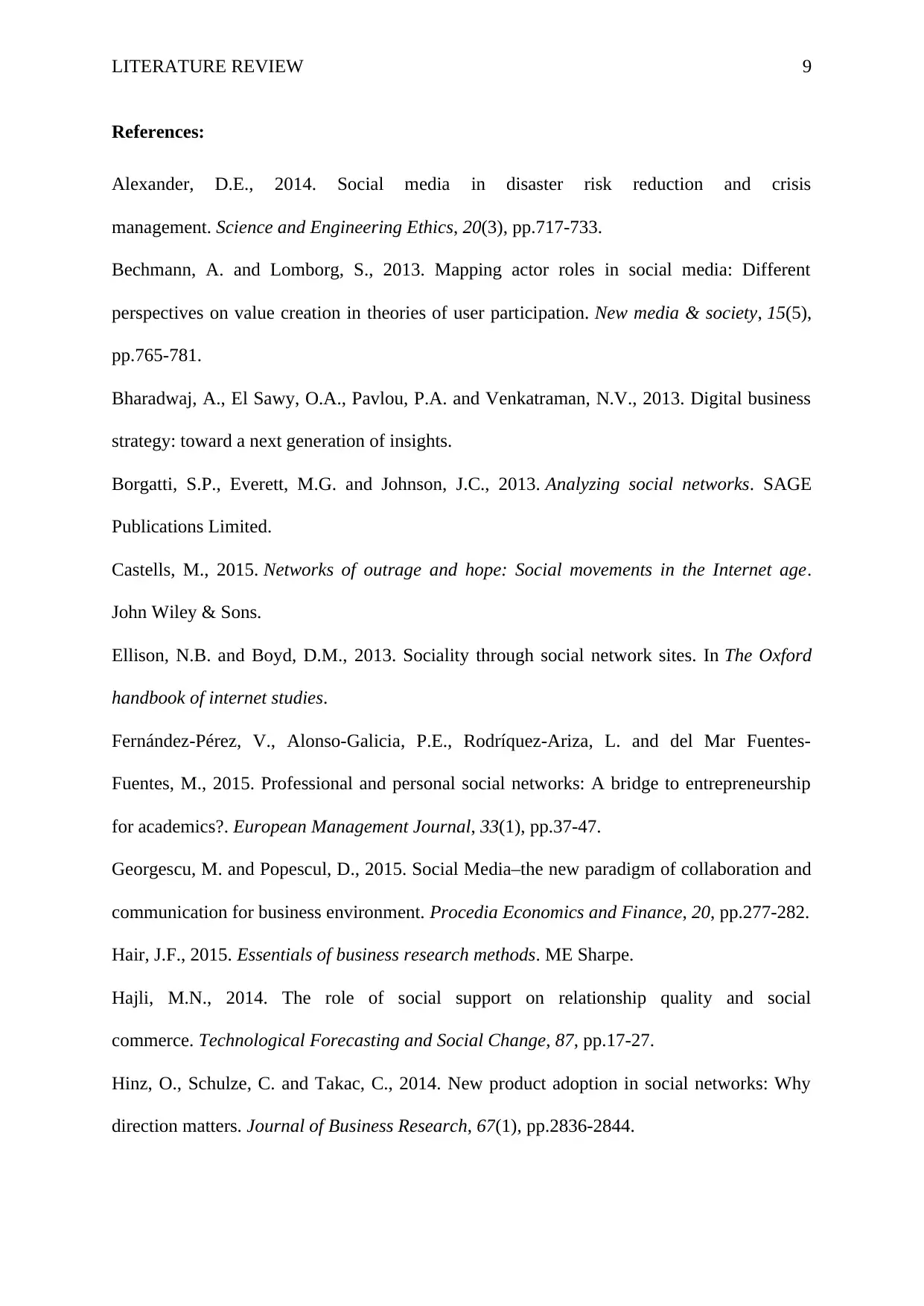
LITERATURE REVIEW 9
References:
Alexander, D.E., 2014. Social media in disaster risk reduction and crisis
management. Science and Engineering Ethics, 20(3), pp.717-733.
Bechmann, A. and Lomborg, S., 2013. Mapping actor roles in social media: Different
perspectives on value creation in theories of user participation. New media & society, 15(5),
pp.765-781.
Bharadwaj, A., El Sawy, O.A., Pavlou, P.A. and Venkatraman, N.V., 2013. Digital business
strategy: toward a next generation of insights.
Borgatti, S.P., Everett, M.G. and Johnson, J.C., 2013. Analyzing social networks. SAGE
Publications Limited.
Castells, M., 2015. Networks of outrage and hope: Social movements in the Internet age.
John Wiley & Sons.
Ellison, N.B. and Boyd, D.M., 2013. Sociality through social network sites. In The Oxford
handbook of internet studies.
Fernández-Pérez, V., Alonso-Galicia, P.E., Rodríquez-Ariza, L. and del Mar Fuentes-
Fuentes, M., 2015. Professional and personal social networks: A bridge to entrepreneurship
for academics?. European Management Journal, 33(1), pp.37-47.
Georgescu, M. and Popescul, D., 2015. Social Media–the new paradigm of collaboration and
communication for business environment. Procedia Economics and Finance, 20, pp.277-282.
Hair, J.F., 2015. Essentials of business research methods. ME Sharpe.
Hajli, M.N., 2014. The role of social support on relationship quality and social
commerce. Technological Forecasting and Social Change, 87, pp.17-27.
Hinz, O., Schulze, C. and Takac, C., 2014. New product adoption in social networks: Why
direction matters. Journal of Business Research, 67(1), pp.2836-2844.
References:
Alexander, D.E., 2014. Social media in disaster risk reduction and crisis
management. Science and Engineering Ethics, 20(3), pp.717-733.
Bechmann, A. and Lomborg, S., 2013. Mapping actor roles in social media: Different
perspectives on value creation in theories of user participation. New media & society, 15(5),
pp.765-781.
Bharadwaj, A., El Sawy, O.A., Pavlou, P.A. and Venkatraman, N.V., 2013. Digital business
strategy: toward a next generation of insights.
Borgatti, S.P., Everett, M.G. and Johnson, J.C., 2013. Analyzing social networks. SAGE
Publications Limited.
Castells, M., 2015. Networks of outrage and hope: Social movements in the Internet age.
John Wiley & Sons.
Ellison, N.B. and Boyd, D.M., 2013. Sociality through social network sites. In The Oxford
handbook of internet studies.
Fernández-Pérez, V., Alonso-Galicia, P.E., Rodríquez-Ariza, L. and del Mar Fuentes-
Fuentes, M., 2015. Professional and personal social networks: A bridge to entrepreneurship
for academics?. European Management Journal, 33(1), pp.37-47.
Georgescu, M. and Popescul, D., 2015. Social Media–the new paradigm of collaboration and
communication for business environment. Procedia Economics and Finance, 20, pp.277-282.
Hair, J.F., 2015. Essentials of business research methods. ME Sharpe.
Hajli, M.N., 2014. The role of social support on relationship quality and social
commerce. Technological Forecasting and Social Change, 87, pp.17-27.
Hinz, O., Schulze, C. and Takac, C., 2014. New product adoption in social networks: Why
direction matters. Journal of Business Research, 67(1), pp.2836-2844.
Paraphrase This Document
Need a fresh take? Get an instant paraphrase of this document with our AI Paraphraser
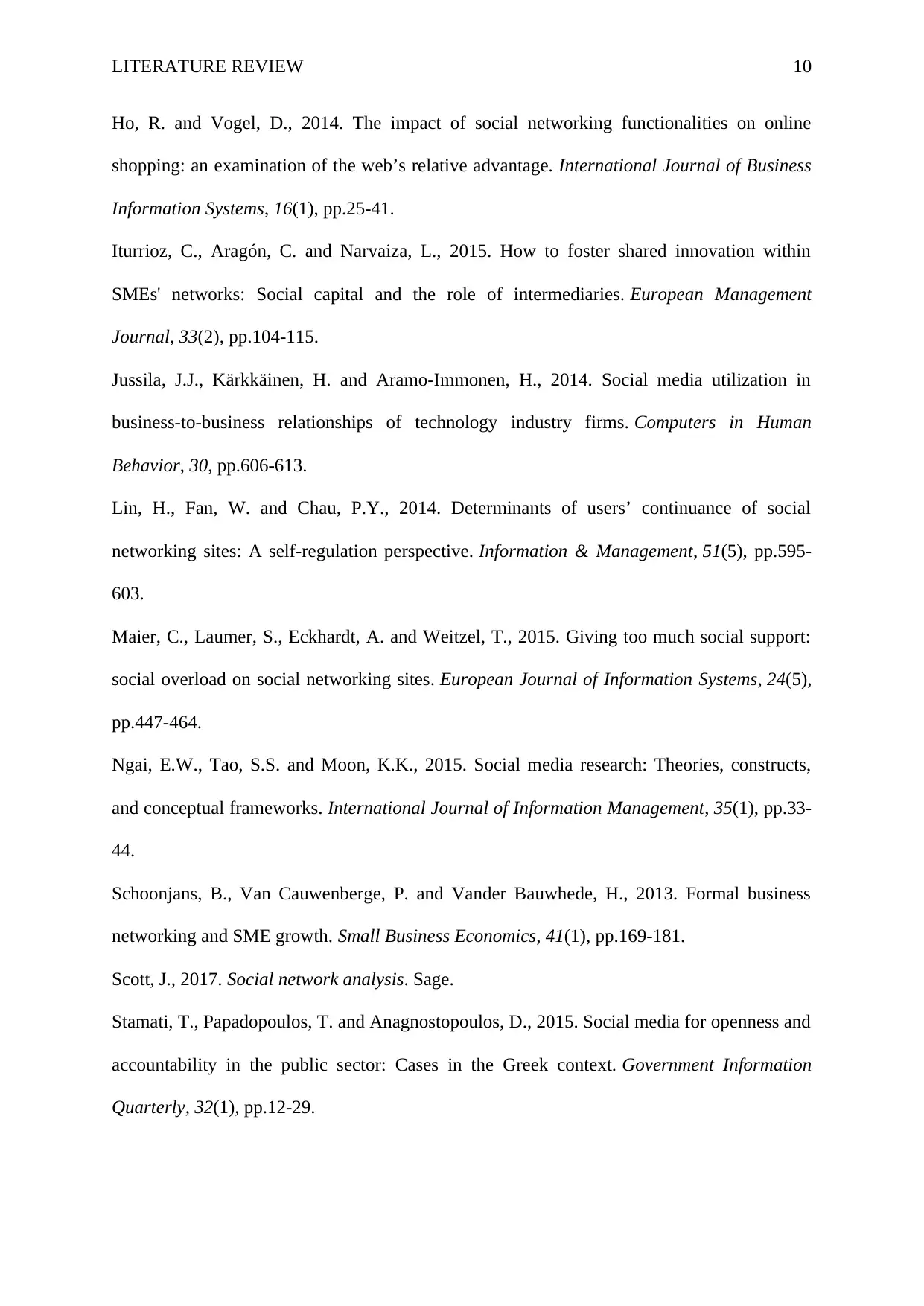
LITERATURE REVIEW 10
Ho, R. and Vogel, D., 2014. The impact of social networking functionalities on online
shopping: an examination of the web’s relative advantage. International Journal of Business
Information Systems, 16(1), pp.25-41.
Iturrioz, C., Aragón, C. and Narvaiza, L., 2015. How to foster shared innovation within
SMEs' networks: Social capital and the role of intermediaries. European Management
Journal, 33(2), pp.104-115.
Jussila, J.J., Kärkkäinen, H. and Aramo-Immonen, H., 2014. Social media utilization in
business-to-business relationships of technology industry firms. Computers in Human
Behavior, 30, pp.606-613.
Lin, H., Fan, W. and Chau, P.Y., 2014. Determinants of users’ continuance of social
networking sites: A self-regulation perspective. Information & Management, 51(5), pp.595-
603.
Maier, C., Laumer, S., Eckhardt, A. and Weitzel, T., 2015. Giving too much social support:
social overload on social networking sites. European Journal of Information Systems, 24(5),
pp.447-464.
Ngai, E.W., Tao, S.S. and Moon, K.K., 2015. Social media research: Theories, constructs,
and conceptual frameworks. International Journal of Information Management, 35(1), pp.33-
44.
Schoonjans, B., Van Cauwenberge, P. and Vander Bauwhede, H., 2013. Formal business
networking and SME growth. Small Business Economics, 41(1), pp.169-181.
Scott, J., 2017. Social network analysis. Sage.
Stamati, T., Papadopoulos, T. and Anagnostopoulos, D., 2015. Social media for openness and
accountability in the public sector: Cases in the Greek context. Government Information
Quarterly, 32(1), pp.12-29.
Ho, R. and Vogel, D., 2014. The impact of social networking functionalities on online
shopping: an examination of the web’s relative advantage. International Journal of Business
Information Systems, 16(1), pp.25-41.
Iturrioz, C., Aragón, C. and Narvaiza, L., 2015. How to foster shared innovation within
SMEs' networks: Social capital and the role of intermediaries. European Management
Journal, 33(2), pp.104-115.
Jussila, J.J., Kärkkäinen, H. and Aramo-Immonen, H., 2014. Social media utilization in
business-to-business relationships of technology industry firms. Computers in Human
Behavior, 30, pp.606-613.
Lin, H., Fan, W. and Chau, P.Y., 2014. Determinants of users’ continuance of social
networking sites: A self-regulation perspective. Information & Management, 51(5), pp.595-
603.
Maier, C., Laumer, S., Eckhardt, A. and Weitzel, T., 2015. Giving too much social support:
social overload on social networking sites. European Journal of Information Systems, 24(5),
pp.447-464.
Ngai, E.W., Tao, S.S. and Moon, K.K., 2015. Social media research: Theories, constructs,
and conceptual frameworks. International Journal of Information Management, 35(1), pp.33-
44.
Schoonjans, B., Van Cauwenberge, P. and Vander Bauwhede, H., 2013. Formal business
networking and SME growth. Small Business Economics, 41(1), pp.169-181.
Scott, J., 2017. Social network analysis. Sage.
Stamati, T., Papadopoulos, T. and Anagnostopoulos, D., 2015. Social media for openness and
accountability in the public sector: Cases in the Greek context. Government Information
Quarterly, 32(1), pp.12-29.

LITERATURE REVIEW 11
Tsiotsou, R.H., 2015. The role of social and parasocial relationships on social networking
sites loyalty. Computers in Human Behavior, 48, pp.401-414.
Tsiotsou, R.H., 2015. The role of social and parasocial relationships on social networking
sites loyalty. Computers in Human Behavior, 48, pp.401-414.
⊘ This is a preview!⊘
Do you want full access?
Subscribe today to unlock all pages.

Trusted by 1+ million students worldwide
1 out of 12
Related Documents
Your All-in-One AI-Powered Toolkit for Academic Success.
+13062052269
info@desklib.com
Available 24*7 on WhatsApp / Email
![[object Object]](/_next/static/media/star-bottom.7253800d.svg)
Unlock your academic potential
Copyright © 2020–2025 A2Z Services. All Rights Reserved. Developed and managed by ZUCOL.




